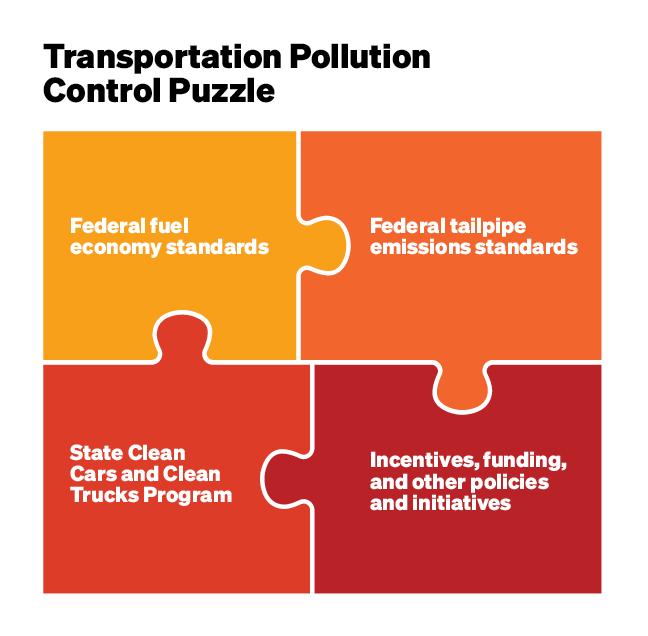The transportation sector is the largest source of greenhouse gas pollution not only in the South, but throughout the United States. A majority of transportation-related greenhouse gas emissions come from light-duty vehicles—primarily passenger cars and smaller trucks. The transportation sector is also a significant source of other pollutants, including nitrogen oxides, carbon monoxide, and particulate matter, and ambient ozone, which are all linked to serious health impacts. Trucks are responsible for an outsized share of this pollution. Though comprising less than 10 percent of all vehicles on the road, medium- and heavy-duty vehicles emit over 60 percent of tailpipe nitrogen oxides and particulate matter pollution.
A complex set of fuel economy and tailpipe emissions standards are the main tools currently available to states as they attempt to control vehicle pollution. At the federal level, the Biden administration is working to undo regulatory rollbacks the Trump administration made. Strengthening these standards, and steps states can take to tackle vehicle pollution, are critical to improving public health and fighting climate change, as well as ending the disproportionate burden of transportation pollution on communities of color and low-wealth communities.
SELC recently filed comments on EPA’s proposed new standards to control greenhouse gas and other pollution from medium- and heavy-duty vehicles. This is just the latest step in our advocacy for strong federal standards that minimize transportation pollution and incentivize the equitable transition to zero-emission vehicles (ZEVs). We’re also encouraging states to take advantage of opportunities to go beyond federal standards to bring the many benefits of curbing transportation pollution to the Southeast. Pollution control standards need to be supplemented by funding and complementary policy initiatives. For example, seventeen states and Washington, D.C. have signed the voluntary Multi-State Medium- and Heavy-Duty Zero-Emissions Initiative that commits jurisdictions to a goal of having 100 percent of medium- and heavy-duty vehicle sales be ZEVs by 2050. Funding is needed to provide cleaner alternatives to driving, such as transit and freight and passenger rail, as well as to promote the use of ZEVs through funding for electric charging stations and incentives to purchase electric cars, trucks, school and transit buses, and other vehicles. SELC is working to advance clean transportation funding at the federal, state, and local level—such as transformative rail funding in Virginia and $7.5 billion for electric vehicle charging in the new federal infrastructure law.
The transportation pollution control puzzle
Working together, a variety of fuel economy and tailpipe emissions standards can greatly reduce transportation’s impact.
Fuel economy standards
Nationwide fuel economy standards are established by the National Highway Traffic Safety Administration. The standards that apply to passenger cars and light-duty trucks are called the Corporate Average Fuel Economy (CAFE) standards, and there is a similar set of standards for heavy-duty vehicles. SELC provided comments on the more stringent CAFE standards that undo significant rollbacks during the Trump administration that were recently adopted, and the Biden administration plans to finalize the next iteration of fuel economy standards for all vehicle types by July 2024.
Tailpipe emission standards
While there is one set of national fuel economy standards, states have a choice between two tailpipe emissions standards: federal tailpipe emissions standards set by EPA or tailpipe emissions standards the Clean Air Act allows California to establish. California’s standards—known as the Clean Cars and Clean Trucks programs—have been more stringent than the federal standards because of the state’s severe air pollution problems.

Federal tailpipe standards
While states have the option to adopt California’s more stringent standards, federal tailpipe emissions standards remain in place in many states and serve as the regulatory floor. SELC has worked at the federal level to ensure that EPA adopts tailpipe emissions standards that are strong enough to clean up transportation pollution and incentivize the transition to ZEVs nationwide.
EPA is currently updating tailpipe emission standards for some medium-duty and all heavy-duty vehicles and a final rule is expected before the end of 2022. EPA also plans to finalize new GHG and other pollutant emissions standards for passenger cars and light-duty trucks by July 2024 that will apply to model year 2027 and later vehicles.
Clean cars and trucks standards
California’s Clean Cars program—currently called the Advanced Clean Cars—has two components: low-emission vehicle (LEV) standards and zero-emission vehicle (ZEV) standards. The program runs through model year 2025, and California is now adopting a second phase of the program with stronger standards for both catagories. In 2021, SELC helped draft and pass legislation that enabled Virginia to become the first state in the South to adopt the Clean Cars program.
Similar to the Clean Cars program, California’s truck pollution controls are comprised of two standards: the Heavy-Duty Omnibus Regulation and the Advanced Clean Trucks (ACT) program. SELC is currently working with a coalition of groups to encourage North Carolina to adopt the ACT.
A clean transportation future
Bold action is needed to clean up transportation pollution. SELC will continue advocating for strong fuel economy and tailpipe emissions standards at the federal level, as well as state adoption of more protective tailpipe standards. These standards, however, are only part of the equation. Just as important is our continued work at the federal, state, and local levels to promote deployment of clean transportation technologies and expand alternatives to driving. This comprehensive approach is essential to bringing the benefits of clean transportation to communities throughout the South.
[ad_2]
Originally Appeared Here